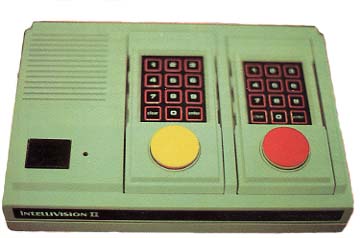
|
REVIEW
OF INTELLIVISION II
BY OWEN LINZMAYER
Surpassed in number of units sold only by the Atari VCS, the original Intellivision is the second most popular game system in homes today. With the introduction of a revamped and less expensive-master component, the Intellivision II, Mattel is trying to present "a whole new look."
In an effort to provide a more competitive system, the designers at Mattel have pared the unit down to the bare essentials. What is left is a very compact white plastic console, (10" X 6.5" X 2.75") that is compatible with the majority of Intellivision cartridges already on the market. (For some reason, the game cartridges currently manufactured by Coleco Industries do not work with the Intellivision II. Efforts are being made by Coleco to correct this problem.)
The most notable feature of the Intellivision II is that unlike those found on the original system, the new controllers are detachable. This means that third party joystick manufacturers will be able to provide better controllers that plug right into the joystick port instead of requiring the user to disassemble the unit.

|
Unless you are a true glutton for punishment, you are bound to find that the disc controller of the Intellivision II is a real pain in the asteroid. Unfortunately for those who would like to install an Injoy-A-Stick, the controllers themselves can not be opened up. Until a new joystick is introduced, you can alleviate the problems created by the controller with a set of Thumb Saver disc cushions available from Video Masters of Mt. Clemens, MI.
Aside from the directional disc, there is a 12-function keypad and a set of four action buttons on the controller. The plastic coated keypad offers no tactile response when pressed. The four buttons are positioned two to a side. Each button is addressed individually, which means that each can control a separate action. The cord that connects the controller to the master console is of the coil variety commonly found on telephone handsets.
The cartridge slot is located on the righthand side of the unit. Since cartridges are inserted horizontally, there is no way for dust to build up on the edge connector inside. Both the old Intellivoice and the redesigned speech synthesis module can be plugged into the cartridge slot.
On the top face of the Intellivision II is a light emitting diode (LED) power indicator and a dual function button. I like the idea of the light to tell you that the power is on, but the button is another matter. The first time that you press the button, the master console is turned on. If you tap it at any time when the unit is on, the game in progress resets. This is fine. The thing that bugs me is that you must press the button down, and keep it depressed for three to five seconds to shut the system off. I would have liked to see two separate switches, one for power and another to reset, instead of this bothersome dual function button.

|
Both the video and power cables are detachable and plug into the back of the unit. The switch to select the viewing channel (either 3 or 4) is clearly marked and easily accessible. The Intellivision II package comes complete with a low voltage power transformer and a TV switch box to flip between regular television viewing and game playing. The 15-page owner's manual is detailed and has many illustrations to help you get your system installed and running. A rather extensive troubleshooting checklist and a copy of the 90-day limited warranty can both be found in this manual.
Mattel plans to support their new machine by introducing an Atari VCS emulator module sometime this summer. Coupled with the Expansion System A, the Intellivision II will be able to play any of the hundreds of Atari 2600 game cartridges on the market.
Also planned for release this year is the Entertainment Computer System which is really the long-awaited Intellivision keyboard. The ECS will feature a 16-bit microprocessor, 2K of random access memory (RAM), and the Basic program language residing in read only memory (ROM). The ECS is set to sell for under $150.